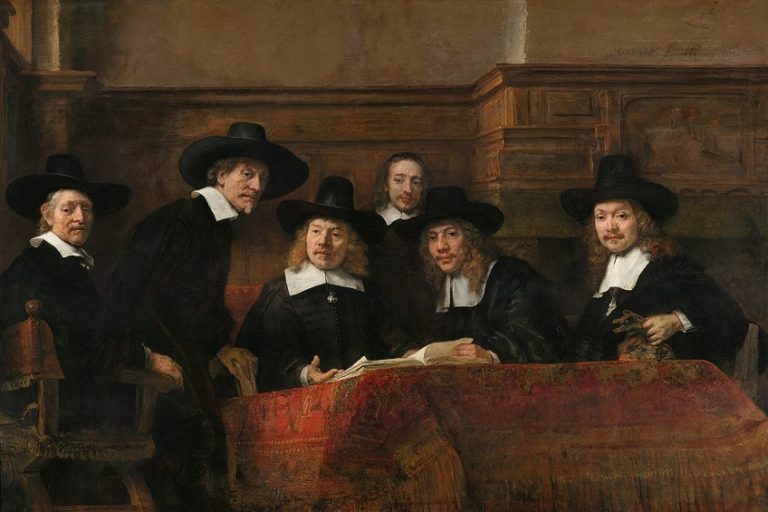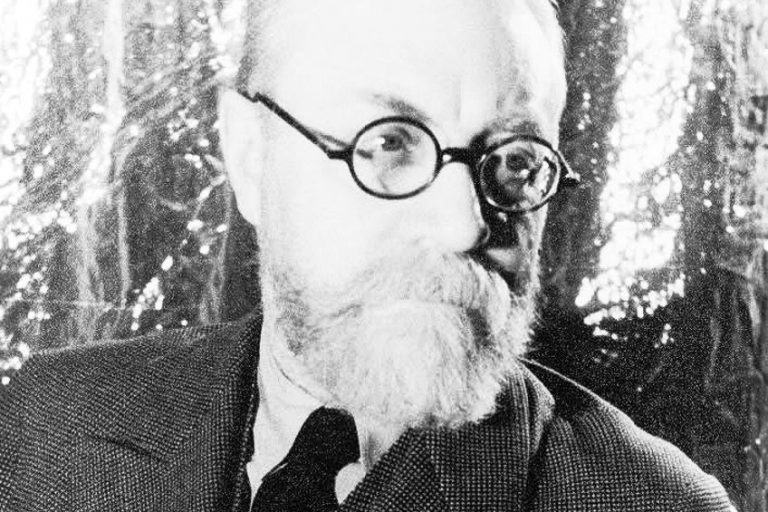“Aspiration” by Aaron Douglas – An Important Artwork Analysis
Aspiration, a masterpiece created by Aaron Douglas in 1936, stands as a profound testament to the Harlem Renaissance and its enduring impact on African American art and culture. This mural, rich with symbolism and layered with historical references, captures the essence of African American progress and aspiration in the face of adversity. Douglas’s use of bold geometric shapes, silhouetted figures, and a monochromatic palette creates a dynamic visual narrative that guides the viewer through the trials, triumphs, and spiritual journeys of Black Americans. Aspiration not only reflects Douglas’s unique artistic style but also his deep commitment to portraying the strength and resilience of his community, making it a pivotal work in the canon of American art.
Key Takeaways
- Aaron Douglas’s Aspiration is a significant piece of African American art documenting progress from slavery to freedom.
- The painting uses Egyptian symbols and African American figures to symbolize hope and progress.
- Aspiration captures the historical transition from the South’s agrarian labor to the North’s industrial opportunities.
The Life and Legacy of Aaron Douglas
| Artist | Aaron Douglas (1899 – 1979) |
| Date Created | 1936 |
| Medium | Oil on canvas |
| Genre | Historical painting |
| Period/Movement | Harlem Renaissance |
| Dimensions (cm) | 152.4 × 152.4 |
| Series/Versions | Single version |
| Where Is It Housed? | Fine Arts Museums of San Francisco, California, United States |
| What It Is Worth | Not publicly auctioned; significant cultural and historical value |
Aaron Douglas’s painting, Aspiration, stands as a beacon of cultural and historical significance within African American art. Commissioned for the Texas Centennial Exposition in 1936, the painting eloquently narrates the journey from slavery to freedom, intertwining elements of African heritage with the hope for a future free from racial discrimination. Aspiration merges Egyptian symbols with modern African American figures to symbolize progress and aspiration, offering a rich tapestry of visual storytelling that continues to resonate.

Douglas’s work not only reflects his own artistic prowess but also serves as a documentary of the African American experience. The painting’s composition links the historical progression of blacks from transatlantic slavery to the innovations and freedoms of future generations. Through his meticulous use of oil on canvas, Douglas captures the essence of struggle and triumph, making Aspiration a vital piece in understanding the evolution of African American culture. This artwork highlights the transition from the agrarian labor of the South to the industrial opportunities of the North. With layered imagery and profound symbolism, Douglas communicates the ongoing quest for equality and the enduring spirit of progress.
Aspiration remains a poignant reminder of the resilience and aspirations that drive cultural advancement.
Notable Contributions to the Harlem Renaissance
Aaron Douglas was a central figure in the Harlem Renaissance, an era that heralded a resurgence of African American culture, art, and intellectualism. He moved to Harlem in the mid-1920s, where he became an integral part of the artistic community. Douglas’s works often incorporated African themes and aesthetics, setting a new standard for African American art. His illustrations for notable publications like The Crisis and Opportunity, and helped frame the visual narrative of African American identity during this period. He collaborated with prominent figures such as W.E.B. Du Bois and Langston Hughes, contributing to the era’s literary and artistic enrichment. His work was not just about visual appeal; it carried deep socio-political messages aimed at inspiring hope and pride in African American heritage.

Influence on African American Art
Aaron Douglas’s impact on African American artists extends beyond the Harlem Renaissance. His unique style—characterized by silhouetted figures and dynamic compositions—became a defining feature of African American art. Educated at the University of Nebraska and eventually teaching at Fisk University, Douglas influenced a generation of young artists. He emphasized the importance of African heritage and cultural pride, which became fundamental themes in African American art. His paintings, such as Aspiration, consistently blend historical references with contemporary issues, offering both a celebration of African culture and a critique of racial injustice.
Douglas’s legacy lies in his ability to merge art with activism, leaving an indelible mark on the progress of African American cultural expression.
Historical Context and Impact
Aspiration by Aaron Douglas is a poignant representation of African American progress and dreams, created during a significant cultural moment in America’s history. This section explores Douglas’s involvement in the Texas Centennial Exposition, the significance of The Hall of Negro Life, and the artwork’s lasting influence.

Aaron Douglas at the Texas Centennial Exposition
In 1936, Aaron Douglas was invited to create artworks for the Texas Centennial Exposition, a major event held in Dallas to celebrate Texas’s 100th anniversary. Douglas’s Aspiration was commissioned for The Hall of Negro Life, an exhibit that aimed to highlight African American achievements and culture. The Hall’s displays featured contributions from prominent African Americans such as Benjamin Banneker, George Washington Carver, Jesse Owens, and Joe Louis. Douglas’s painting was one of four pieces created for the exposition, with Aspiration being one of the survivors.
The inclusion of Aspiration in the exhibit was a pivotal moment in demonstrating African American cultural and historical contributions during a time of rampant segregation and racial discrimination.
The Hall of Negro Life and Racial Discrimination
The Hall of Negro Life was a groundbreaking exhibit. It showcased African American achievements in various fields, countering the prevalent racial discrimination and stereotypes of the Jim Crow South. The inclusion of this segregated building in the Texas Centennial represented a significant, albeit limited, recognition of African Americans’ contributions to American society. The Hall aimed to challenge the widespread racial discrimination by emphasizing African Americans’ historical and contemporary accomplishments. This included scientific achievements by figures like George Washington Carver and cultural contributions from personalities like Paul Robeson. However, the Hall’s segregated nature underscored the persistence of racial barriers. Its existence at the exposition was symbolic yet highlighted the ongoing struggle for true equality and representation.

Continuing Influence on Modern Art and Society
Aspiration continues to resonate with modern audiences due to its profound themes and artistic execution. The painting’s depiction of the journey from slavery to freedom, incorporating Egyptian symbolism, connects African American heritage to a broader historical narrative. Today, Aspiration is housed in the Fine Arts Museums of San Francisco, where it remains accessible to the public. Its visibility in a major museum reinforces its enduring significance. The artwork’s influence extends beyond its historical context, inspiring contemporary artists and thinkers.
It serves as a reminder of the ongoing aspirations for equality and recognition within society, reflecting on both past struggles and future hopes.
Analyzing Aspiration: Themes and Symbolism
Aspiration by Aaron Douglas stands out for its rich symbolic imagery, representation of history, and impactful use of color and form. This painting encapsulates the journey from the past to the hopeful future of African Americans.

Symbolic Imagery and African Heritage
Douglas incorporates powerful imagery linking African Heritage to Human Aspiration. The pyramids and other Ancient Egyptian art elements symbolize wisdom and cultural pride. These symbols connect the African American experience to a prestigious past, countering European claims of cultural supremacy. The silhouetted figures in the painting reach towards a star, symbolizing their quest for freedom and enlightenment.
This visual metaphor illustrates the drive to rise above past injustices, represented by elements such as the slave ships in the background.

Depictions of the Past and Future
The background of Aspiration portrays the grim history of slavery with dark, looming slave ships. In contrast, the mid-ground shows figures emerging from this dark past, stepping towards the light, symbolizing progress and freedom. At the forefront, futuristic skyscrapers symbolize the future—aspirational, modern, and unbound.
This suggests a vision where African Americans have transcended historical restraints and achieved great advancements.

Use of Color and Form in Aspiration
Douglas’s color palette and form choices powerfully convey the painting’s themes. The background uses dark colors to depict the oppressive past. Moving towards the foreground, colors brighten, symbolizing hope and aspiration. Radiating circles surround the star towards which the figures reach, emphasizing the focal point of human aspiration. The geometric forms and stark contrasts between light and dark highlight the ongoing journey from a constricted past to a free, promising future.
These artistic choices not only enhance the visual appeal but also deepen the narrative of overcoming adversity and striving for a better future.

Aspiration remains a powerful and evocative representation of African American resilience and progress. Through his distinctive use of silhouette and geometric abstraction, Douglas crafts a narrative that transcends time, illustrating the unyielding spirit and enduring aspirations of a community striving for equality and recognition. This mural not only embodies the artistic innovation of the Harlem Renaissance but also serves as a timeless reminder of the ongoing journey toward justice and empowerment. Aspiration continues to inspire and resonate, reaffirming Douglas’s legacy as a pivotal figure in American art history.
Frequently Asked Questions
What Is the Significance of the Imagery Used in Aaron Douglas’s Aspiration?
The painting Aspiration uses symbolic imagery to depict the journey from slavery to freedom. Egyptian symbols and modern African American figures illustrate progress. The artist connects African heritage with a hopeful future. The figures on the plinth symbolize strength and striving toward enlightenment and progress.
How Does Aspiration by Aaron Douglas Reflect the Harlem Renaissance Ideals?
Aspiration embodies the ideals of the Harlem Renaissance by celebrating African American culture and history. It portrays a narrative of overcoming racial discrimination and moving towards a promising future. Douglas utilizes historical references to emphasize pride in African heritage and the collective effort for social advancement.
What Artistic Techniques Did Aaron Douglas Employ in the Creation of Aspiration?
Aaron Douglas employed monochromatic color schemes and silhouetted figures in Aspiration. The use of geometric forms and a composition that guides the viewer’s eye upward reinforces the theme of ascent and aspiration. His technique creates a visual link between African American experiences and broader themes of empowerment and progress.
Isabella studied at the University of Cape Town in South Africa and graduated with a Bachelor of Arts majoring in English Literature & Language and Psychology. Throughout her undergraduate years, she took Art History as an additional subject and absolutely loved it. Building on from her art history knowledge that began in high school, art has always been a particular area of fascination for her. From learning about artworks previously unknown to her, or sharpening her existing understanding of specific works, the ability to continue learning within this interesting sphere excites her greatly.
Her focal points of interest in art history encompass profiling specific artists and art movements, as it is these areas where she is able to really dig deep into the rich narrative of the art world. Additionally, she particularly enjoys exploring the different artistic styles of the 20th century, as well as the important impact that female artists have had on the development of art history.
Learn more about Isabella Meyer and the Art in Context Team.
Cite this Article
Isabella, Meyer, ““Aspiration” by Aaron Douglas – An Important Artwork Analysis.” Art in Context. June 19, 2024. URL: https://artincontext.org/aspiration-by-aaron-douglas/
Meyer, I. (2024, 19 June). “Aspiration” by Aaron Douglas – An Important Artwork Analysis. Art in Context. https://artincontext.org/aspiration-by-aaron-douglas/
Meyer, Isabella. ““Aspiration” by Aaron Douglas – An Important Artwork Analysis.” Art in Context, June 19, 2024. https://artincontext.org/aspiration-by-aaron-douglas/.











